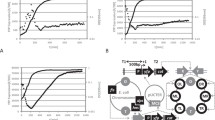Summary
We have constructed several plasmids to test the specificity of target selection for IS102 associated deletions. We had previously shown that the cIII region of phage lambda is a target for IS102 mediated deletions and this region was therefore introduced in pSC101, where IS102 resides, in such a way that it was silent, transcribed or fully expressed. The deletion selection was provided by the galactokinase system. The results we have obtained show that transcription of the target region is required for deletion formation. The frequency of deletions in this target depends on its position along the transcript and is also influenced by translation. Implications of these results on the regional specificity of transposition are discussed.
Similar content being viewed by others
References
Bernardi A, Bernardi F (1981) Site-specific deletions in the recombinant plasmid pSC101 containing the redB-ori region of phage lambda. Gene 13:103–109
Bernardi F, Bernardi A (1984) Atypical deletions generated by mutated IS102 elements. Mol Gen Genet 195:452–458
Bernardi F, Bernardi A (1986) Intramolecular transposition of IS102. Gene 42:11–19
Bernardi F, Bernardi A (1987) Identification of the promoter regions present on IS102. Life Sci Adv Mol Genet, in press
Birnboim HC, Doly J (1979) A rapid alkaline procedure for screening recombinant plasmid DNA. Nucleic Acids Res 7:1513–1523
Bishop R, Sherratt D (1984) Transposon Tn1 intramolecular transposition. Mol Gen Genet 196:117–122
Blackwell TK, Moore MW, Yancopoulos GD, Suh H, Lutzker S, Selsing E, Alt FW (1986) Recombination between immunoglobulin variable region gene segments is enhanced by transcription. Nature 324:585–589
Brosius J (1984) Plasmids vectors for the selection of promoters. Gene 27:151–160
Buttin G (1963) Mécanismes régulateurs dans la biosynthèse des enzymes du métabolisme du galactose chez Escherichia coli I. La biosynthèse induite de la galactokinase et l'induction simultanée de la séquence enzymatique. J Mol Biol 7:164–182
Calos MP, Miller JH (1980) Transposable elements. Cell 20:579–595
Chiang S, Jordan E, Clowes RC (1982) Intermolecular and intramolecular transposition and transposition immunity in Tn3 and Tn2660. Mol Gen Genet 187:187–194
Cohen SN, Chang ACY (1973) Recircularization and autonomous replication of a sheared R factor DNA segment in Escherichia coli transformants. Proc Natl Acad Sci USA 70:1293–1297
Cohen SN, Chang ACY (1977) Revised interpretation of the origin of the pSC101 plasmid. J Bacteriol 132:734–737
Daniels DL, Schroeder JL, Szybalski W, Sanger F, Coulson AR, Hong GF, Hill DF, Petersen GB, Blattner FR (1983) Complete annotated lambda sequence. In: Hendrix RW, Roberts JW, Weisberg RA (eds) Lambda II. Cold Spring Harbor Laboratory Press, New York, pp 519–676
Datta R, Rosner J (1987) Reduced transposition in rho mutants of Escherichia coli K-12. J Bacteriol 169:888–890
Dente L, Cesareni G, Cortese R (1983) pEMBL: a new family of single stranded plasmids. Nucleic Acids Res 11:1645–1655
Gamper HB, Hearst JE (1982) A topological model for transcription based on unwinding angle analysis of E. coli RNA polymerase. Binary, initiation and ternary complexes. Cell 29:81–90
Jaurin B, Normark S (1983) Insertion of IS2 creates a novel ampC promoter in Escherichia coli. Cell 32:809–816
Knight MD, Echols H (1983) The cIII gene and protein of bacteriophage lambda. J Mol Biol 163:505–510
Luk KC, Szybalski W (1983) The tL2 cluster of transcription termination sites between genes bet and ral of coliphage lambda. Virology 125:403–418
McKenney K, Shimatake H, Court D, Schmeissner U, Brady C, Rosenberg M (1981) A system to study promoter and terminator signals recognized by E. coli RNA polymerase. In: Chirikjian JG, Papas TS (eds) Gene amplification and analysis, vol 2. Elsevier North Holland, New York Amsterdam Oxford, pp 384–415
Newbury SF, Smith NH, Robinson EC, Hiles ID, Higgins CF (1987) Stabilization of translationally active mRNA by prokaryotic REP sequences. Cell 48:297–310
Nisen PD, Kopecko DJ, Chou J, Cohen SN (1977) Site-specific DNA deletions occurring adjacent to the termini of a transposable ampicillin resistance element (Tn3). J Mol Biol 117:975–998
Noel KD, Ferro-Luzzi Ames G (1978) Evidence for a common mechanism for the insertion of Tn10 transposition and for Tn10 stimulated deletion. Mol Gen Genet 160:217–223
Prentki P, Teter B, Chandler M, Galas DJ (1986) Functional promoters created by the insertion of transposable element IS1. J Mol Biol 191:383–393
Rosenberg M, Chepelinsky AB, McKenney K (1983) Studying promoters and terminators by gene fusion. Science 222:734–739
Sanger F, Coulson AR, Barrell BG, Smith AJH, Roe BA (1980) Cloning in single-stranded bacteriophage as an aid to rapid DNA sequencing. J Mol Biol 143:161–178
Schümperli D, McKenney K, Sobieski DA, Rosenberg M (1982) Translation coupling at an intercistronic boundary of the Escherichia coli galactose operon. Cell 30:865–871
Sengstag C, Arber W (1983) IS2 insertion is a major cause of spontaneous mutagenesis of the bacteriophage P1: non random distribution of target sites. EMBO J 2:67–71
Sengstag C, Arber W (1987) A cloned DNA fragment from bacteriophage P1 enhances IS2 insertion. Mol Gen Genet 206:344–351
Shine J, Dalgarno L (1974) The 3′-terminal sequence of Escherichia coli 16S ribosomal RNA: complementarity to nonsense triplets and ribosome binding sites. Proc Natl Acad Sci USA 71:1342–1346
Vieira J, Messing J (1987) Production of single stranded plasmid DNA. Methods Enzymol 153:3–11
Voelkel-Meiman K, Keil RL, Roeder GS (1987) Recombinationstimulating sequences in yeast ribosomal DNA correspond to sequences regulating transcription by RNA polymerase I. Cell 48:1071–1079
Weinert TA, Schaus NA, Grindley NDF (1983) Insertion sequence duplication in transpositional recombination. Science 222:755–765
Author information
Authors and Affiliations
Additional information
Communicated by H. Böhme
Rights and permissions
About this article
Cite this article
Bernardi, F., Bernardi, A. Transcription of the target is required for IS102 mediated deletions. Mol Gen Genet 212, 265–270 (1988). https://doi.org/10.1007/BF00334695
Received:
Issue Date:
DOI: https://doi.org/10.1007/BF00334695




